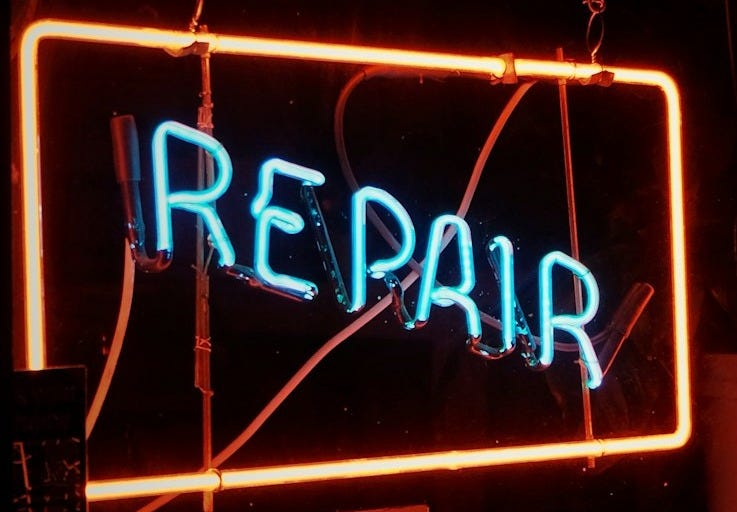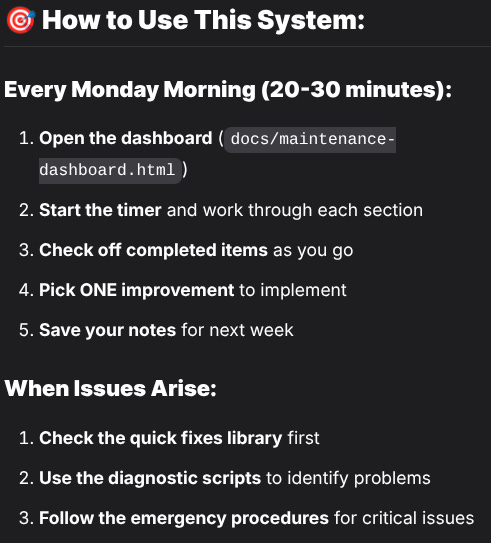How to Vibe Code for Free – Part 11: The Secret to Apps That Don’t Rot
Practical tips for keeping your app fresh, functional, and fun... without endless late nights.
Launching an app is exciting, but maintaining it is where the real work - and the real burnout risk - begins.
I learned this when my test users (my kids) started using my first “vibe-coded” app, ChoreBuddies. I was beaming. They managed to log in, then looked at me, and said, “Why is the screen blank?” In two seconds, they found a bug that killed my buzz. Suddenly, the high of launch gave way to the question: How do I keep this thing alive without the late-night panic?
This is what Part 11 is about: not the hype, but the quiet, steady, systematic work of keeping your app running, safe, and evolving.

1. Build a Maintenance Routine
Apps don’t die in one big crash. They slowly fade when no one takes care of them.
That’s why I started scheduling a weekly “maintenance check-in.” Nothing fancy: just 30 minutes once a week to:
Scan error logs
Check feedback/requests
Do one small fix or improvement
Maintenance feels overwhelming when you let it pile up. If you keep it bite-sized, you’ll actually stick to it.
Prompt to Try:
“Help me create a lightweight weekly maintenance checklist for my app. It should cover checking error logs, reviewing user feedback, and identifying one small fix or improvement. Keep it simple enough to do in under 30 minutes.”

2. Protect Against Rot
Apps “rot” when little issues go unnoticed: APIs change, dependencies get outdated, servers silently crash.
Free tools can save you here:
UptimeRobot (free): Pings your app every 5 minutes. If it’s down, you get an email.
Dependabot (built into GitHub): Automatically suggests updates when your libraries or dependencies are outdated.
Think of these like smoke detectors. You hope they never beep, but you’ll be glad when they do.
3. Manage Requests Without Drowning
Once people start using your app, you’ll hear everything: bugs, requests, random ideas. If you try to fix it all at once, you’ll burn out. And possibly make your app bloated.
The trick is triage. Keep requests in one place (Notion, Trello, Tally form), then sort them into three buckets:
Quick Wins: Fixes you can do in <1 hour.
Medium Effort: Worth doing, but needs planning.
Not Now: Nice ideas, but not urgent.
This keeps you from treating every request like a crisis.
Prompt to Try:
“Here’s my current backlog of bug reports and feature requests: [paste list]. Organise them into Quick Wins, Medium Effort, and Not Now. Prioritise which 3 I should tackle first for the biggest user impact.”
4. Balance Stability vs. New Features
The temptation is always to chase new shiny features. But if you only build new things and never fix the old, your app becomes a fragile mess.
I like the 70/30 rule:
70% of each update cycle (this could be a week, 2 weeks, a month-long period) => fixes, polish, and improvements
30% => new features
This way, the app stays reliable while still feeling fresh to your users.
Prompt to Try:
“Help me design a simple update cycle for my app. Each cycle should balance fixing existing bugs with building new features. Suggest a ratio and workflow that keeps the app stable but still evolving.”
5. Plan for Longevity
Ask yourself this: If I stopped working on this app for 3 months, could I return and know what’s going on?
If the answer is no, you need light documentation. Nothing corporate, just a Notion page or README where you track:
Your data model (tables + relationships)
Key features and flows
Known issues / future ideas
It’s like leaving yourself a breadcrumb trail. Future-you will thank present-you.
Prompt to Try:
“Create a lightweight documentation template for my app that covers: 1) data model, 2) core features and flows, 3) known issues, 4) wishlist features. Keep it simple enough to update quickly after each release.”
Small Win (Do This Today)
Set up UptimeRobot to monitor your app. It takes 2 minutes, and you’ll get an email the moment your app goes down. That’s free peace of mind = no midnight surprises.
You are not a billion-dollar company. You are one person, vibe-coding for fun, or maybe just to help a few people. The secret to apps that don’t rot isn’t endless time, it’s a solid, 30-minute system.
Master the triage, build the routine, and you’ve already won the maintenance battle.



